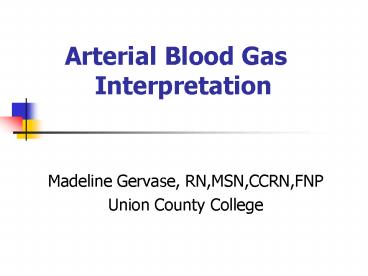Arterial Blood Gas Interpretation - PowerPoint PPT Presentation
1 / 25
Title:
Arterial Blood Gas Interpretation
Description:
Normal value 35-45mmHg. Analysis. HCO3 = Metabolic. HCO3 = Metabolic. Normal values 22-26/28 mEq/L ... ( hyperventilation) Determine Primary Cause of Disturbance ... – PowerPoint PPT presentation
Number of Views:658
Avg rating:3.0/5.0
Title: Arterial Blood Gas Interpretation
1
Arterial Blood Gas Interpretation
- Madeline Gervase, RN,MSN,CCRN,FNP
- Union County College
2
Blood Gas Components
- Oxygen level
- Carbon Dioxide Level
- pH
- Bicarbonate level
3
ABG Analysis
- pH 7.35-7.45
- PaCO2 35-45mmHg
- HCO3 22-26/28 mEq/L
- PaO2 gt 80mmHg
- Oxygen Saturation gt95
4
Analysis
- pH Alkalosis
- pH Acidosis
- Normal values 7.35-7.45
5
Analysis
- PaCO2 Respiratory
- PaCO2 Respiratory
- Normal value 35-45mmHg
6
Analysis
- HCO3 Metabolic
- HCO3 Metabolic
- Normal values 22-26/28 mEq/L
7
Comparison Chart
8
Respiratory Acidosis
- Any disease process which decreases the
- ability of the lungs to exchange CO2 for
- oxygen.
- Increased K
- Pneumonia
- Asthma
- CHF
9
Respiratory Acidosis
10
Respiratory Alkalosis
- Anything which greatly increases
- respiratory rate.
- Fever
- Pain
- Anxiety
- Overvenitilation with a mechanical venitalator
- Decreased K
11
Respiratory Alkalosis
12
Metabolic Acidosis
- Anything which increases the
- accumulation of acids or decreases the
- amount of bicarbonate in the body.
- ?Renal failure
- ?Loss of bases from diarrhea
- ?Increased K
- ?Diuretic therapy which causes HCO3 loss
13
Metabolic Acidosis
14
Metabolic Alkalosis
- Anything which decreases H ions in
- The body or increases bicarbonate.
- ?Prolonged vomiting
15
Metabolic Alkalosis
16
Determining ABGs
- First, Look at the pH.
- It can be high gt7.45 (alkalosis)
- It can be low lt7.35 (acidosis)
- It can be normal 7.35- 7.45 (normal)
17
Determining ABGs
- A normal pH may indicate perfectly normal blood
gases, or it may be an indication of a
compensated imbalance. - A compensated imbalance is one in which the
body has been able to correct the pH by either
respiratory or metabolic changes (depending on
the primary problem)
18
Example of compensation
- Pt. With primary metabolic acidosis starts out
with a low bicarbonate level but a normal carbon
dioxide level. Soon afterward, the lungs try to
compensate for the imbalance by exhaling large
amounts of carbon dioxide. (hyperventilation)
19
Determine Primary Cause of Disturbance
- Evaluate the PaCo2 HCO3 in relation to the pH.
- PaCo2 35-45mmHg
- HCO3 22-26 mEq/L
20
Interpreting ABGs
- pH gt 7.45 (alkalosis) and the PaCO2 is,
- lt 35 mmHg, the primary disturbance is
respiratory alkalosis. This occurs when a pt.
hyperventilates and blows off too much carbon
dioxide. - pH gt 7.45 (alkalosis) and the HCO2 is gt 26 mEq/L,
the primary disturbance is metabolic alkalosis.
This situation occurs when the body gains too
much bicarbonate, an alkaline substance.
21
Interpreting ABGs
- pH lt7.35 (acidosis) and the PaCO2 is gt 40mmHg,
the primary disturbance is respiratory acidosis.
This situation occurs when a patient
hypoventilates and thus retains too much carbon
dioxide, an acidic substance.
22
Interpreting ABGs
- pH lt 7.35 (acidosis) and the HCO3 is
- lt 22mEq/L, the primary disturbance is metabolic
acidosis. This situation occurs when the bodys
bicarbonate level drops , either because of
direct bicarbonate loss or because of gains of
acids such as lactic acid or ketones.
23
Determine if compensation has begun
- This is done by looking at the value other than
the primary disorder. If it is moving in the
same direction as the primary value, compensation
is underway.
24
Examples
- Consider the following gases
- pH PaCO2 HCO3
- 1)7.20 60mmHg 24mEq/L
- 2)7.33 60mmHg 37mEq/L
- indicates acute respiratory acidosis without
compensation (the PaCO2 is high, the HCO3 is
normal). - Indicates chronic respiratory acidosis,
compensation has taken place that is HCO3 has
elevated to an appropriate level to balance the
high PaCo2 ands produce a normal pH.
25
Example of compensation
- A patient with primary respiratory acidosis
starts out with a high carbon dioxide level soon
afterward, the kidneys attempt to compensate by
retaining bicarbonate. If the compensatory
maneuver is able to restore the bicarbonate to
carbonic acid ratio back to 201, full
compensation (and thus normal pH) will be
achieved.































